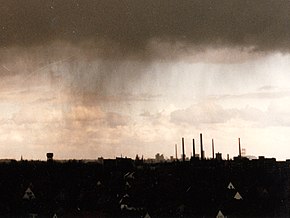Downpour

Cloudburst colloquially describes a mostly short, extremely heavy precipitation that can "put everything under water". Cloudbursts occur very often in connection with thunderstorms and are often mixed with sleet or hail . They fall from particularly high-reaching clouds , the upper limits of which can in extreme cases be more than 15 kilometers.
Heavy rain is not yet a downpour. Hailstones and raindrops are kept in the air by strong, thermal updrafts and rain down more or less heavily in a thunderstorm, for example. Changes in winds, strong cooling of the lower layers or mountain ranges can cause this upwelling suddenly to collapse. The cloud content can no longer be held and is emptied in a very short time. There are downpours or hailstorms.
Most downpours occur during severe summer thunderstorms (heat thunderstorms, less often with frontal thunderstorms) and within the first three minutes after the onset of rain. They are mostly a local phenomenon and can accumulate in certain places. For example, places in the Inn Valley south of Brannenburg are affected by downpours and hail several times a year. On the other hand, cloudbursts rarely occur in Neubeuert , a few kilometers away .